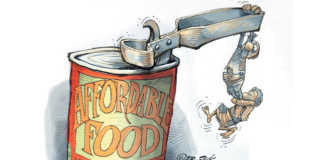
Change (read as variability) in the climate has existed since the Earth was formed. Debates on its causes are not of primary importance to livestock farmers; what is relevant to them is to know the current phase of climate variability, as this will determine the mitigation measures they should take.
Changes happening
Before one can discuss how to adapt to a variable or changing climate, it is important to take note of the climate fluctuations predicted over the past 30 to 40 years, and which of these have been realised. Two predictions of climate change have relevance to the current generation of livestock farmers:
- The world would become warmer. The latest measurements show that the average annual temperature over South Africa has increased about 1°C over the recent past, and farmers have to plan for this.
- The amount and distribution of rainfall would change, with an initial expectation that the western parts of South Africa would become drier and the eastern parts wetter, and more extreme weather patterns could be expected.
The latest scientific observations show a marginal decrease in rainfall during the autumn months over the central and north-eastern parts of South Africa, but the annual total rainfall has not changed significantly.
What has also been observed is that the average number of rainy days per year has decreased over the central and north-eastern areas. If the total rainfall has remained the same but the number of rainy days has decreased, it is logical that rainfall intensity has increased, and the wetter periods have become wetter and the dry periods drier. Thus, the prediction of more extreme weather conditions seems to be accurate, and farmers should take this into consideration in their management plans.
There is no current consensus among scientists on future changes in rainfall patterns across South Africa.
Consequences of higher CO2 levels for plant growth
Since the early 1800s, the carbon dioxide (CO2) concentration in the Earth’s atmosphere has increased from about 275 parts per million (ppm) to over 400 ppm, and it is still rising.
Plants absorb CO2 , using it for plant growth through photosynthesis.
Carbon, hydrogen and oxygen make up about 96% of the dry mass of plants. One can therefore expect that with more CO2 in the atmosphere, plants will grow better.
The latest field research indicates an average increase of 17% in above-ground plant production, and about 30% in root growth due to the higher atmospheric CO2 concentrations on Earth.
A number of factors determine the extent of increased atmospheric CO2 on the increase in plant growth. The first is the specific photosynthetic pathway of the plant.
There are three pathways, namely C3 , C4 and crassulacean acid metabolism (CAM). Cool-season plants, which include shrubs, trees and cool-season grasses, follow the C3 pathway.
Tropical plants, such as tropical grasses, follow the C4 process, and succulents follow the CAM pathway.
Increased CO2 levels benefit the production of both C3 and C4 plants (C3 more than twice as much as C4 plants). This is known as CO2 fertilisation.
The second factor that plays a role in the response to CO2 fertilisation is the availability of nitrogen (N). A lack of N limits the CO2 growth response, while good N provision enhances the effect. Consequently, C3 legumes such as thorn trees are particularly favoured by increased atmospheric CO2 concentration, which leads to greater bush encroachment.
Thirdly, increased CO2 levels improve the water-use efficiency (WUE) of plants. Carbon dioxide is absorbed via the plants’ stomata; when they open to absorb it, the plant loses water to the atmosphere.
With higher CO2 concentrations in the atmosphere, a plant can absorb high quantities of CO2 through stomata that are less open, and a resultant lower loss of water to the atmosphere. This leads to improved WUE. Increases of between 5% and 20% have been reported in the literature.
Negative results of CO2 fertilisation
Carbon dioxide fertilisation increases bush encroachment. The South African Environmental Observation Network has reported dramatic changes in the botanical structure of South Africa’s savanna, grassland and fynbos biomes over the past 100 years.
According to its researchers, the savanna areas are expanding into the adjacent grassland areas, while the existing savanna areas are experiencing a marked increase in bush density. In fact, thickets that are almost impenetrable to humans and animals have formed.
These changes have even been observed in the drier savanna areas.
The grasslands bordering the savanna biome are being invaded by trees and shrubs, while the rest of the area has experienced increased densities of smaller bushes and shrubs, such as slangbos. Even the drier grassland areas have not been spared.
Savanna and grassland are estimated to provide 81% of total available veld grazing capacity in South Africa. Managing bush encroachment is therefore a high priority in these areas.
In the savanna areas, farmers have favoured game farming as a means of relieving the problem, but the success of this strategy is questionable, as it is only the so-called mega browsers, such as elephant and rhino, that are known to suppress this brush significantly.
That leaves most livestock farmers with only two practical management tools: fire and herbicides (arboricides).
Positive results of CO2 fertilisation
Carbon dioxide fertilisation improves the growth of grazing plants while using less water due to improved WUE, provided that sufficient N levels are available in the soil.
Prof Hennie Snyman of the Department of Animal, Wildlife and Grassland Sciences at the University of the Free State has conducted research over many decades which indicates that grassveld in good condition contains significantly higher N levels in the topsoil than veld in poor condition.
Therefore, if one considers that the benefit of CO2 fertilisation is affected by N availability, it is important to ensure that the veld is in excellent condition. The poorer the condition of the veld, the lower the N content and the less the benefit of CO2 fertilisation.
Snyman’s research has also shown that plant species that dominate in healthy grassland have a higher WUE than grasses found in poor veld. These and other benefits make it clear why livestock farmers should strive towards ensuring that their veld is in excellent condition to derive maximum benefit from CO2 fertilisation.
Countermeasures
Two negative outcomes are at play: more intense rainstorms, and a decrease in rainfall frequency, which results in droughts of higher intensity, not necessarily more or longer droughts.
Higher-intensity rainstorms can lead to greater rainwater run-off and soil erosion. The best countermeasure is veld with a high basal cover.
Snyman’s research shows that the run-off from veld in good condition is 3,5% of the annual total rainfall, while that of veld in poor condition is on average 8,71%. He has demonstrated that the soil erosion rate of veld in good condition is 0,41t topsoil/ha/year, while the figure is 3,55t/ha/year for veld in poor condition.
Research by Dr Mias van der Westhuizen, a range and forage science specialist at the Free State Department of Agriculture and Rural Development, has shown that veld in good condition offers the best protection against drought.
For example, with veld in the central Free State in poor condition, the chance of experiencing a fodder shortage is 12 times greater than with veld in good condition. Similarly, with poor veld in the drier Kalahari areas, the chance of a fodder shortage is four times greater than with good veld.
Proactive drought planning is vital for improved drought mitigation.
The latest scientific data shows an increase in South Africa’s average temperature of 1°C. Livestock will thus be subject to more heat stress. But South Africa’s livestock industry has the ability, technology and breeding material to select for animals that can better handle heat conditions.
Research has also shown that increased air temperature can lead to improvement in the productivity of grazing plants, provided that sufficient water is available.
The views expressed in our weekly opinion piece do not necessarily reflect those of Farmer’s Weekly.
Email Dr Louis du Pisani at [email protected].











